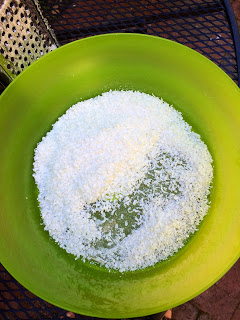“Grandma looked at the horizon, drew a deep breath and said, ‘This is Thunder Cake baking weather, all right. Looks like a storm coming to me.'”
If you haven’t read the book “Thunder Cake” by Patricia Polacco, get yourself to the library or a local book store and get your hands on a copy pronto…you and your kids will love it! The story centers around the author and her grandmother (her Babushka) and the summer storms she feared as a little girl, at her grandmother’s farm in Michigan. I’ve loved reading this book ever since I was a little girl and now L adores it as well.
With the summer heat and thunderstorms we’ve been having lately, I decided it was definitely time to try our hand at baking some real Thunder Cake for ourselves! It’s fun to make memories with your little ones and read this book as your Thunder Cake is baking in the oven…the perfect activity for a lazy, stormy, summer afternoon. It really seems like magic to smell the chocolaty cake baking in your own home as the little girl and her Babushka are putting theirs into the oven as well!
The recipe calls for 1 cup of shortening; we used what we had — 2 sticks of butter — and the result was still wonderful! With the secret ingredient of pureed tomatoes, the flavor of this chocolate cake is very unique, but very moist and delectable as well. I suggest serving your Thunder Cake with extra strawberries…they pair so well with the hint of tomato and make the desert complete!
As instructed in the book:
Cream together, one at a time…
- 1 cup shortening (or 2 sticks of softened butter)
- 1 3/4 cup sugar
- 1 teaspoon vanilla
- 3 eggs, separated (Blend yolks in. Beat whites until they are stiff, then fold in after the tomatoes.)
- 1 cup cold water
- 1/3 cup fresh, pureed tomatoes
Sift together…
- 2 1/2 cups cake flour (We used all-purpose, Gluten Free flour.)
- 1/2 cup dry cocoa
- 1 1/2 teaspoon baking soda
- 1 teaspoon salt
Mix dry mixture into creamy mixture.
Bake in two greased and floured 8 1/2-inch round pans at 350 degrees for 35 to 40 minutes.
Frost with chocolate butter frosting. Top with strawberries.
We used this chocolate buttercream frosting recipe because I had all the ingredients on hand and it was quick and easy. Feel free to use your favorite chocolate buttercream recipe in its place!
Enjoy!!!
Polacco, Patricia. “Thunder Cake.” New York: Scholastic Inc., 1990. Print.



























































































































































